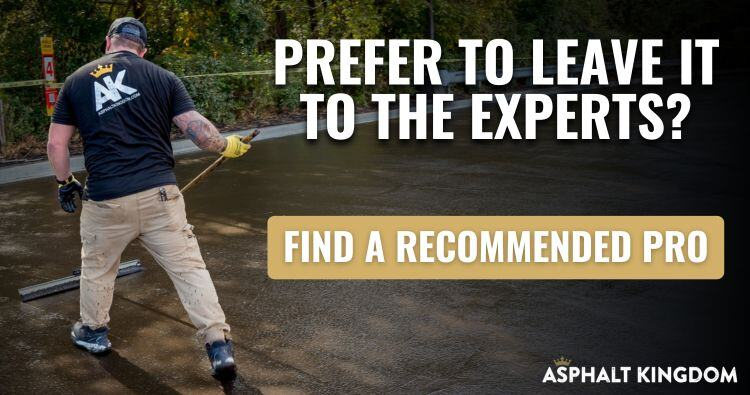You’ve got a pothole that needs to be repaired. Maybe it’s in a residential driveway, or it could be in the middle of a business’s parking lot. Either way, the job’s clear: patch the damage and do it right.
But here’s the question that comes up every time: cold patch or hot mix?
It’s not a small decision. The materials you choose can affect the durability of the repair, how fast the job gets done, and how happy your client is six months down the road.
Let’s take a closer look at cold patch vs hot asphalt, including what each one brings to the table, when to use them, and how to avoid the most common mistakes people make with both.
Table of Contents
- What’s the Difference Between Cold Patch and Hot Asphalt?
- When Cold Patch Makes Sense
- Advantages of Cold Patch
- Cold patch is your best option when you’re dealing with
- When to Choose Hot Mix Asphalt
- Advantages of Hot Asphalt
- Use hot mix when
- Cold Patch vs Hot Patch: Side-by-Side Comparison
- Which Should You Use?
- How to Get the Most from Either Option
- It’s Not One or the Other, It’s What the Job Demands
What’s the Difference Between Cold Patch and Hot Asphalt?
Before we compare them, let’s get clear on definitions:
- Cold patch asphalt is pre-mixed and can be stored in bags or containers. It’s ready to use right out of the package and doesn’t require heating.
- Hot mix asphalt is heated to around 300°F at a plant and must be applied while it’s still hot. It’s the same material used for full paving jobs, not just repairs.
So, we’re really comparing ease and convenience vs durability and longevity. One’s ready when you are, while the other requires planning but lasts longer.
When Cold Patch Makes Sense

Let’s say you’ve got a pothole that needs fixing fast. It’s winter, temperatures are low, and there’s no way a hot plant’s even open. That’s where cold patch works.
Advantages of Cold Patch:
- Ready to use anytime – No need to schedule a trip to the plant or heat the mix.
- Works in cold or wet conditions – Perfect for emergency winter repairs.
- Easy to apply – Just dump, tamp, and walk away.
Cold patch is your best option when you’re dealing with:
- Temporary or emergency repairs
- Remote areas far from an asphalt plant
- Freezing or rainy weather
- Smaller-scale residential or light commercial fixes
But here’s the thing: cold patch is temporary by design. Even the best products don’t fully bond with the existing asphalt. They’ll hold up under light traffic for a few months, maybe even a season. But they don’t have the structural integrity of hot mix.
So, if you’re using cold patch, be honest with yourself and your clients: this is a stopgap, not a forever fix.
When to Choose Hot Mix Asphalt

Hot mix is the gold standard for a reason. It’s what highways, roads, and long-lasting parking lots are made of. If you want a repair that blends seamlessly into the existing pavement and holds up for years, hot mix is the way to go.
Advantages of Hot Asphalt:
- Superior durability – Bonds fully with the existing surface.
- Seamless finish – Looks better and performs better.
- Handles heavy traffic – Ideal for high-use areas.
Use hot mix when:
- You want a permanent fix
- Conditions are warm and dry
- You’re near an operating asphalt plant
- You’re working on heavily trafficked roads or commercial lots
Yes, it takes more coordination. You’ve got to plan your timing, get the mix from the plant, and apply it quickly before it cools. But if you’re after quality and longevity, it’s worth the effort.
Cold Patch vs Hot Patch: Side-by-Side Comparison
Here’s a quick snapshot to help you compare:
Feature |
Cold Patch |
Hot Mixed Asphalt |
|---|---|---|
Application Temp |
Any time, even cold/wet |
Warm, dry weather only |
Equipment Needed |
Basic hand tools |
Roller, compactor, sometimes saws |
Cure Time |
Immediate traffic allowed |
Needs time to cool and cure |
Durability |
Temporary (weeks to months) |
Long-term (years) |
Bonding Strength |
Surface-level adhesion |
Full bonding with base |
Ideal Use Case |
Emergency or small jobs |
Permanent, high-traffic repairs |
Cost (short term) |
Lower upfront cost |
Higher upfront, lower long-term |
Availability |
Always available |
Dependent on plant schedule/weather |
Which Should You Use?
It comes down to a few key questions:
- Is this a temporary fix or a long-term solution? If it’s urgent and short-term, go cold patch. If you’re aiming for a lasting repair, hot mix wins.
- What are the current weather and ground conditions? Hot mix can’t be used in cold, wet, or freezing environments. Cold patch doesn’t mind the weather.
- How much time do you have? Cold patch is quick. You’re in and out. Hot mix takes more time, equipment, and planning.
- What’s the traffic level? High-traffic areas demand hot mix. A cold patch just won’t cut it for long under constant pressure.
- What’s your client expecting? Sometimes the client just needs it done now. Other times, they’re counting on a repair that’ll outlast the season. Managing expectations is part of the job.
How to Get the Most from Either Option
Whatever material you choose, your technique still matters. A bad application can ruin a good product.
Tips for cold patch:
- Clear out loose debris and moisture first.
- Overfill the hole slightly; compaction will level it out.
- Use a hand tamper or vibratory plate for best results.
Tips for hot mix:
- Cut clean edges around the pothole with a saw.
- Remove all debris and compact the base layer.
- Apply tack coat for better bonding.
- Compact in layers if needed.
And regardless of the method, follow up. A cold patch might need reapplication. A hot patch might need sealcoating down the line.
It’s Not One or the Other, It’s What the Job Demands
Cold patch vs hot patch isn’t a battle. It’s a decision based on requirements. You wouldn’t use a hammer when you need a wrench, and the same goes for asphalt. Both methods have their place. Your job is to know when (and how) to use them.
So, the next time you’re standing over a pothole, ask yourself: What’s the best way to solve this problem for the long haul? Not just today, but next season, next year, next time it snows or floods or freezes.
The right choice goes beyond the materials. The goal is to think like a professional, understand your environment, and choose the method that fits the situation.







-2.jpg)
-1.jpg)